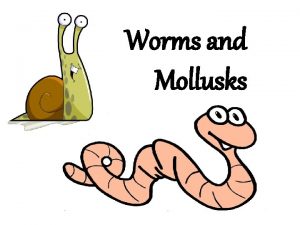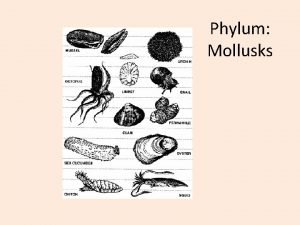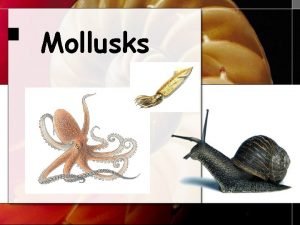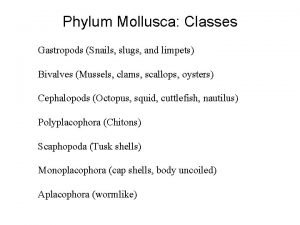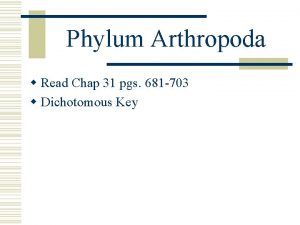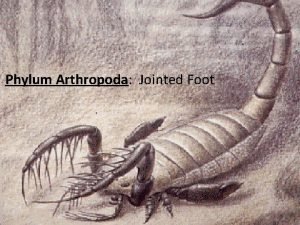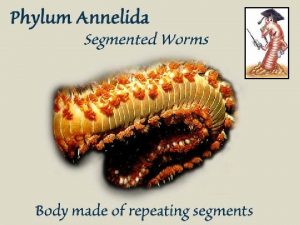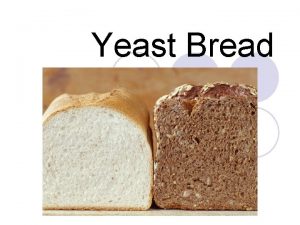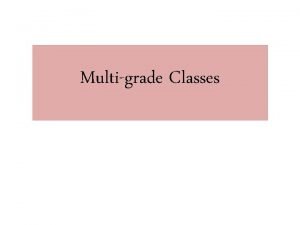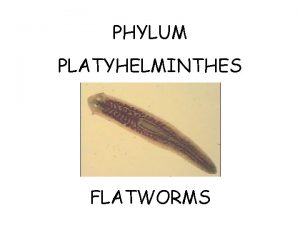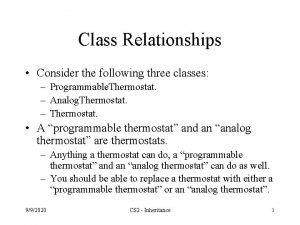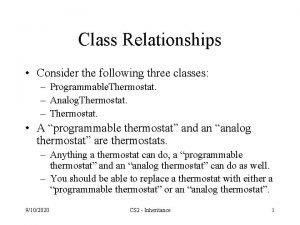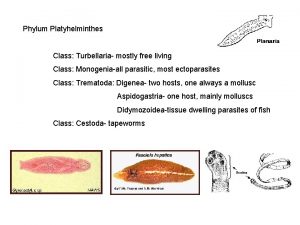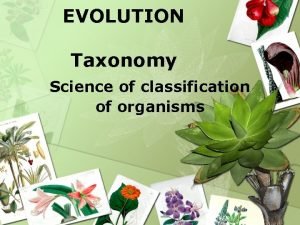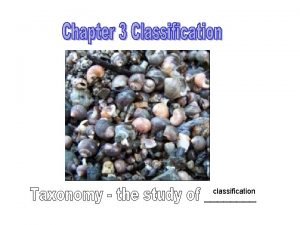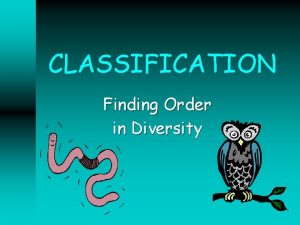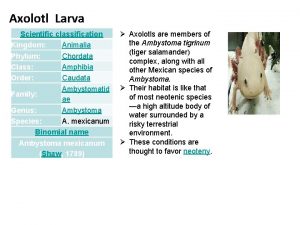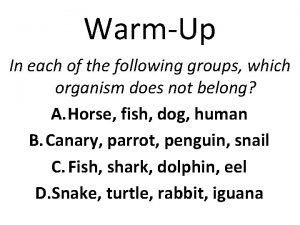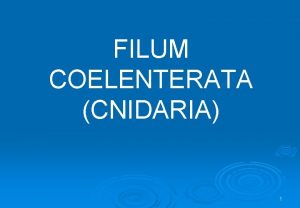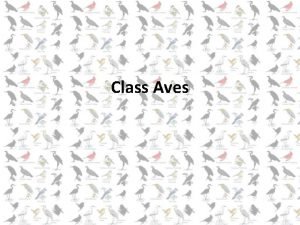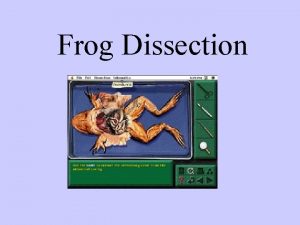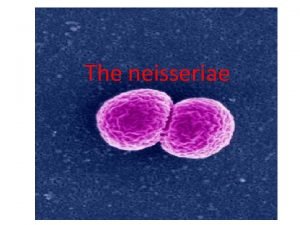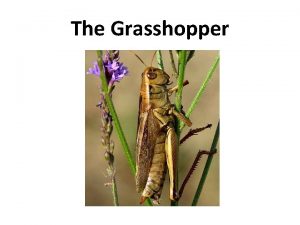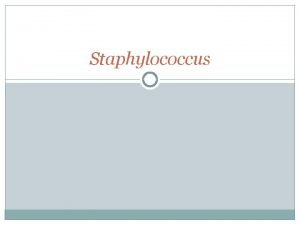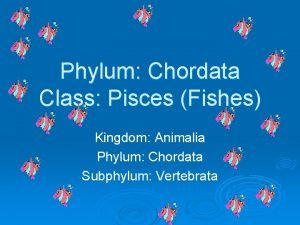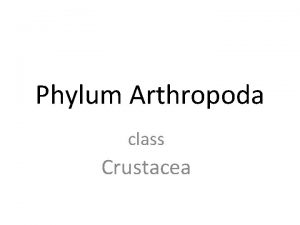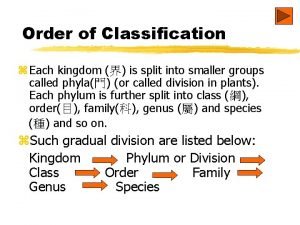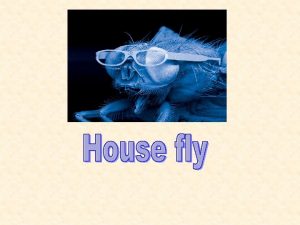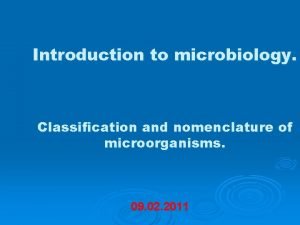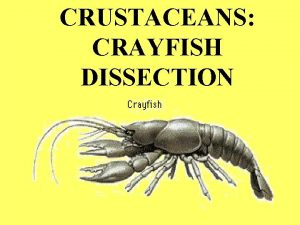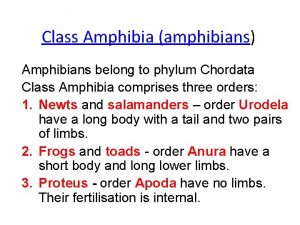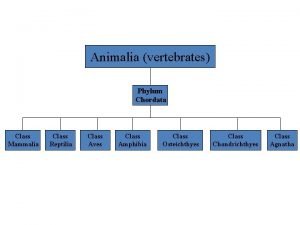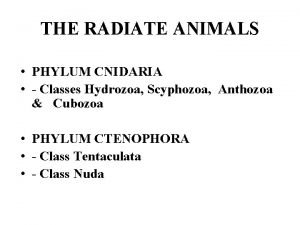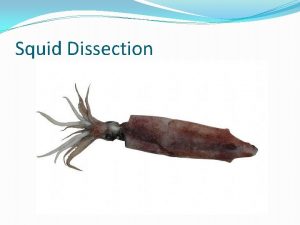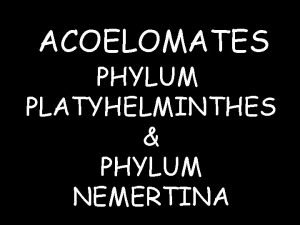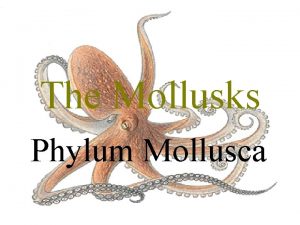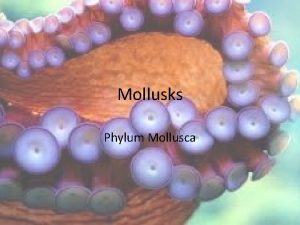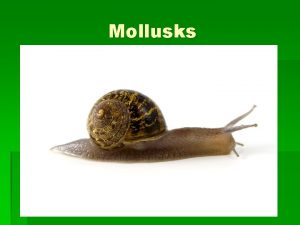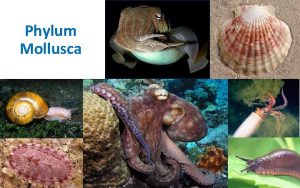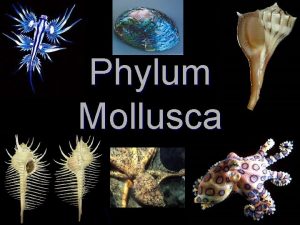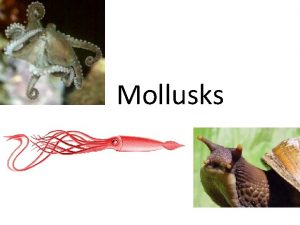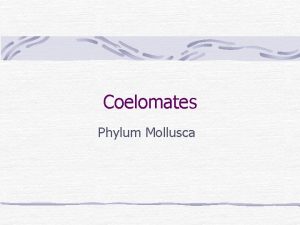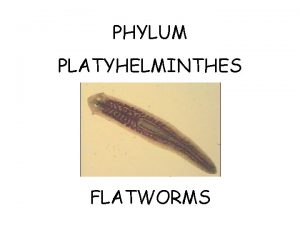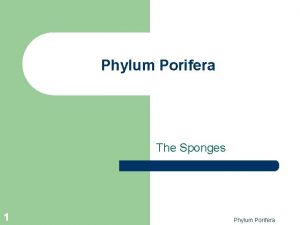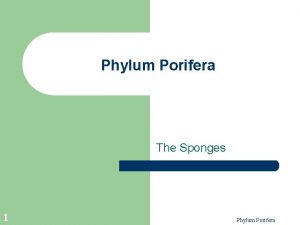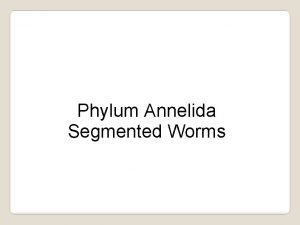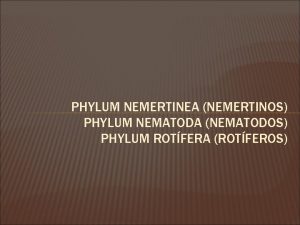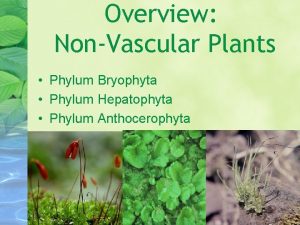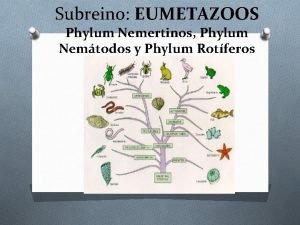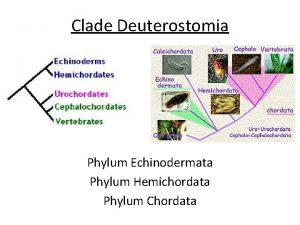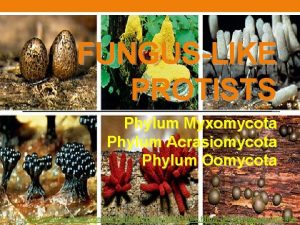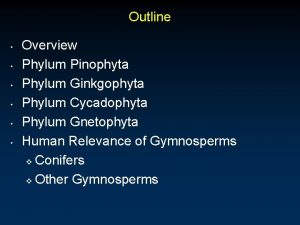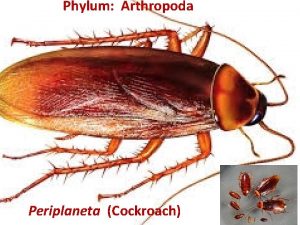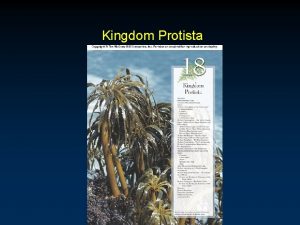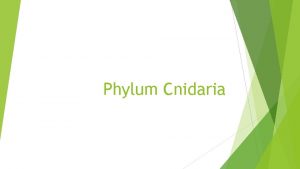Phylum Mollusks Three Classes of Mollusks 1 Class





















































- Slides: 53

Phylum: Mollusks

Three Classes of Mollusks 1. Class Gastropoda – snails, slugs 2. Class Bivalvia – clams, oysters, mussels, scallops 3. Class Cephalopoda – octopi, squids and cuttlefishes

Basic information 1. Over 100, 000 living species 2. Marine, fresh water, and land 3. Most Bilateral symmetry

Body Plan • Divided into two regions: 1. head/foot 2. visceral mass

Head/foot • Head (contains mouth and variety of sensory structures) • Foot (muscular organ used for locomotion)

Visceral Mass 1. 2. 3. 4. heart digestion excretion reproduction

Mantle 1. Covers and protects the visceral mass 2. Secretes shell

mantle cavity • Location of gills • Space between the mantle and the visceral mass

nervous system • Ganglia: paired cluster of nerve cells 1. locomotion 2. feeding 3. process sensory information (light, touch)


Feeding • Radula: flexible, tongue like strip of tissue covered with tough abrasive teeth that point backward

Feature Gastropoda Bivalvia Cephalopoda External Shell 0 -1 Two None (except nautilus) Head Yes No Yes Radula Yes No Yes Locomotion Crawl sessile Rapid swimming

Class Gastropoda

Basic Information • • Most diverse class of mollusks 90, 000 species Snails, abalones, conches= single shell Slugs and nudibranchs= no shell

Torsion • Visceral mass twists around 180° in relation to the head • Twisting results in mantle cavity, gills, and anus to the front of the animal • Gastropod is now able to with drawl its head into mantle cavity when threatened


Movement • foot secrets a substance allowing animal to glide over surfaces (Slime Trail)

Open circulatory system • HEMOLYMPH (blood in an organism with open circulation) does not remain in vessels 1. Collected from gills or lungs 2. Pumped through heart 3. Released directly into spaces in the tissues a) Fluid filled spaces or blood cavity



Bivalvia: Clams Other Bivalvia: scallops, mussels, oysters

Characteristics 1. 2. 3. 4. 5. Sessile Filter feeders No radula No cephalization Aquatic

Anatomy of Valves • Shell is divided into two halves (valves) • Connected by a hinge • Adductor muscles – Contract: close valves – Relax: open vlaves

Clam Sensory information • 3 pairs of ganglia – mouth (cerebral) – digestive system (visceral) – Foot (pedal)

Foot • Foot helps burrow in the sand or mud

Water flow • water enters through incurrent siphon • Water exits through excurrent siphon

Steps in digestion: Filter Feeders 1. Cilia in gills set up water current 2. Gills filter water for small organisms 3. Palps: flaplike structures that surround & guide food into the clam's mouth 4. Food then enters the mouth

Steps in Digestion: Filter Feeders 4. Stomach: Digestion begins 5. Digestive glands: digested particles are absorbed 6. Intestines: collects and removes digestive wastes 7. Waste are passed through the rectum and excreted through anus



Function of Gills 1. Trap food particles 2. Exchange oxygen and carbon dioxide

Growth rate • Umbo oldest part of the clam • Growth rings

CLASS CEPHALOPODA Most advanced class

Cephalopod “Head-foot” • foot is concentrated in the head region • foot is modified into arms and tentacles equipped with suckers • Foot also forms funnel (siphon) for expelling water, allowing movement by "jet propulsion"

Squid

Cuttlefish

The major distinction between the squid and octopus Squid suction cups are armed with hooks or sucker rings (or a combination of the two). Octopus have simple suction cups without secondary armature. Squid Suction Cups Tentacle club of Architeuthis, showing circularsaw-like sucker rings. tentacle club of Mesonychoteuthis, with swiveling hooks.

Profile of Mesonychoteuthis tentacle club, showing hooks. Suction cups of Haliphron atlanticus, the giant gelatinous octopus (the world's largest species of octopus), lacking secondary armature.

Giant Squid Can reach length of up to 60 feet and weight of more than 3. 5 tons. Architeuthis dux

Nautilus

Octopus

Locomotion • Jet propulsion by using siphon to force water out • Crawling – octopus *Also uses siphon

External Features • Octopus: 8 arms with either one or two rows of suction cups (but never hooks or sucker rings), • Squid/cuttlefish: 10 appendages containing suction cups (contain either hooks or sucker rings) • 8 arms • 2 tentacles

Ink – All except nautilus have ink sack which empties into rectum; ink contains the pigment melanin (same pigment as human skin) – Released when the animal is alarmed. The animal quickly departs from the scene leaving the ink as a decoy to the predator.

Color Changes • Chromatophores – pigment cells that expand contract to produce color change. – Used as danger signals, protective coloring, and for courtship. The Blue Ringed Octopus (found in shallow coral and rock pools of Australia): It’s poisonous saliva is 10, 000 more potent than cyanide. This octopus is only the size of a golf ball but carries enough poison to kill 26 humans in minutes.



Feeding 1. Fish, other mollusks, crustaceans, worms 2. Beak like jaws and radula tear prey into pieces 3. Octopus and Cuttlefish have poison in saliva

Circulatory • Closed circulatory system • Blood delivers oxygen and nutrients directly to organs through veins and arteries


Nervous System • Well-developed brain; eyes which are similar in construction to vertebrate eyes • FYI: The giant squid has the largest eye of any animal, either living or extinct. In a 55 -foot specimen the diameter was 15. 74 inches. In comparison, a blue whale's eye has the diameter of 4. 70 inches, and humans have an eye diameter of. 94 inches.

Reproduction 1. Male or Female 2. The male uses arm to take sperm from own mantle cavity and insert into females mantle cavity 3. The female lays ~100 eggs and guards them until they hatch (approx 50 days) 4. Frequently the mother dies soon after the eggs hatch because during the guarding of the eggs she is unable to eat.

Squid Vs Octopus
 What are three classes of mollusks
What are three classes of mollusks Classes in phylum mollusca
Classes in phylum mollusca Oysters
Oysters Classes de palavras e subclasses
Classes de palavras e subclasses Pre ap classes vs regular classes
Pre ap classes vs regular classes Classes of phylum mollusca
Classes of phylum mollusca Dichotomous key
Dichotomous key Daphnia
Daphnia One of the representatives of phylum arthropoda is
One of the representatives of phylum arthropoda is Phylum annelida classes
Phylum annelida classes 3 types of yeast breads
3 types of yeast breads Advantages and challenges of multigrade teaching
Advantages and challenges of multigrade teaching Lever fishing rod
Lever fishing rod Taenia belongs to which phylum
Taenia belongs to which phylum Three classes of intruders in network security
Three classes of intruders in network security Consider the following three classes
Consider the following three classes Consider the following three classes
Consider the following three classes Kingdom family genus species
Kingdom family genus species Classification of asterias
Classification of asterias Kingdom phylum class order
Kingdom phylum class order Maize classification
Maize classification Genital atrium
Genital atrium Pig domain kingdom phylum class
Pig domain kingdom phylum class Horse kingdom classification
Horse kingdom classification Kingdom phylum class order of humans
Kingdom phylum class order of humans Genus species
Genus species Biology
Biology Kingdom phylum class order
Kingdom phylum class order Axolotl larva classification
Axolotl larva classification Kingdom phylum class order of humans
Kingdom phylum class order of humans King phillip came over from great spain
King phillip came over from great spain Cnidaria subkingdom
Cnidaria subkingdom Subphylum aves
Subphylum aves Frog
Frog Bacteria phylum
Bacteria phylum Phylum grasshopper
Phylum grasshopper Bacteria kingdom phylum class order
Bacteria kingdom phylum class order Sraep
Sraep Platypus class
Platypus class Pisces kingdom animalia
Pisces kingdom animalia Crustacean phylum
Crustacean phylum Domain kingdom phylum
Domain kingdom phylum Domain kingdom phylum class order family genus species
Domain kingdom phylum class order family genus species Kingdom animalia phylum chordata class mammalia
Kingdom animalia phylum chordata class mammalia Diptera
Diptera Microbes importance
Microbes importance Crayfish kingdom
Crayfish kingdom Phylum chordata class amphibia
Phylum chordata class amphibia Earthworm phylum and class
Earthworm phylum and class Phylum chordata class reptilia
Phylum chordata class reptilia Mollusca class
Mollusca class Bristle worm phylum
Bristle worm phylum Anthozoa scyphozoa hydrozoa
Anthozoa scyphozoa hydrozoa Taxonomy of squid
Taxonomy of squid
